Have you ever had problems with your PCM (powertrain control module)? Are you noticing Ford F150 PCM Failure symptoms?
It would be wise to address the situation as quickly as possible because it can become complicated, making you spend more on fixes. No worries, you are in the right place to learn all you can about PCM. My guide has information on the top 9 most common F150 PCM problems and their symptoms.
Generally, the most common F150 PCM failure symptoms include: inability to connect diagnostic scan tool, check engine light illumination, rough or even no start, low gas mileage, failed emissions test, engine stalling, difficult shifting, getting PCM-related error codes, misfires and backfires.
With the tips provided here, you can also get the best possible deal on a Ford F150 PCM reset and replacement. It’d be worth reading. Let’s start without further ado!

Top 9 Most Common Ford F150 PCM Failure Symptoms
A powertrain control module can work abnormally because of several factors. I will discuss some of those factors later. For now, see some of the usual F150 computer problem signs below.
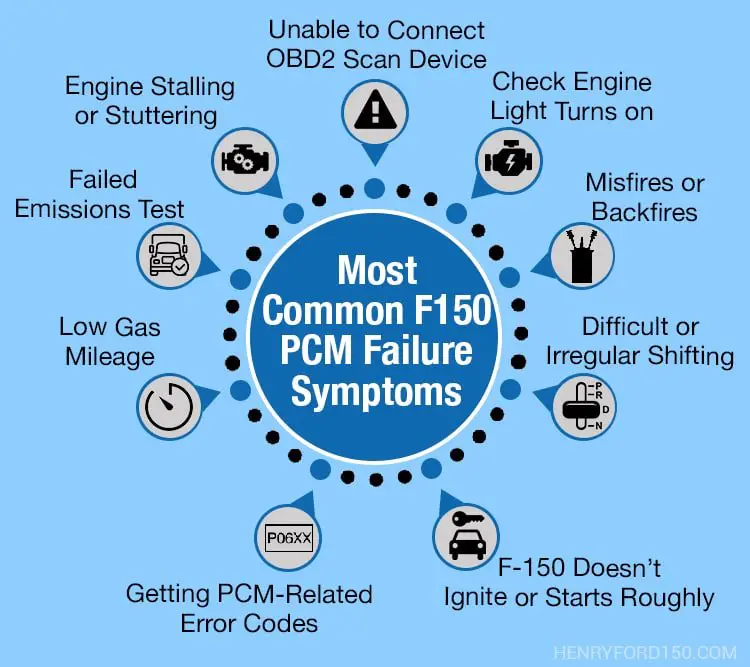
Unable to Connect OBD2 Scan Device
The inability to successfully use your diagnostic scan tool may mean that something is up with your truck’s PCM. Therefore, it is advisable to check the working condition of the PCM relay and diode in the fuse panel under the vehicle’s hood. The failure of any of the two components will make the PCM unresponsive.
Check Engine Light Turns on
When the check engine light (CEL) illuminates, there may be an issue with your pickup’s PCM. The CEL may come on when the self-diagnostic cycle of your F150 fails. Other possible sources of this symptom can be the powertrain, sensors, wiring, etc. Ensure that you check other components before concluding that the issue results from a defective PCM.
F-150 Doesn’t Ignite or Starts Roughly
It might be hard to start the vehicle when the PCM is malfunctioning, especially in the winter. Your truck may not even start at all, depending on the severity of the situation. A failing starter or weak battery may be the culprit, but don’t forget to consider the PCM as a likely cause.
Fix the problem without delay if the PCM triggered it. For instance, stalling may lead to a catastrophic engine failure. You would even have to get a new engine, PCM, and any other component affected by the problem. Utilize an OBD2 diagnostic tool to read the trouble codes and get tips on making repairs.
Low Gas Mileage
Reduced fuel economy is another sign of an abnormally functioning powertrain control module, and you shouldn’t overlook it. This also means an unusual increase in fuel consumption. For instance, you will be accelerating more than normal if the turbo doesn’t produce an adequate boost. This is because the PCM failed to give the needed instructions.
Another cause of low gas mileage is the poor control of the engine’s air-to-fuel ratio or gear shift. Don’t overlook the possibility of inappropriate tire air pressure and a bad filter as factors.
Failed Emissions Test
A well-performing PCM will minimize your pickup’s emissions. But there will be an increase in emissions when the unit malfunctions, resulting in an emissions test failure.
Engine Stalling or Stuttering
A malfunctioning powertrain control module can make your vehicle’s engine delay or stop running. The culprit may also be another component, such as bad ignition coils.
Difficult or Irregular Shifting
A defective PCM can cause difficult or abnormal shifting into gears. This transmission problem is a critical one that you shouldn’t treat with levity. Rectify it ASAP to avoid issues with handling that can make you lose control when driving. A worst-case scenario is an accident or collision occurring on the road.
Getting PCM-Related Error Codes
You can ensure that the module is defective when you see an error code in the scan result. Utilize a diagnostic tool when you notice that the unit is misbehaving. More issues will come up as the PCM’s performance worsens. Examples of PCM error codes are P0606, P0603, P0113, U0100, etc. Most error codes that start with “P06” indicate PCM conditions.
Misfires or Backfires
It will be hard for the PCM to regulate the mixture of fuel and air into the engine if there is a defective oxygen sensor in the combustion system. This situation may cause an engine to misfire and lead to the illumination of the CEL.
The powertrain control module may flash an error code for a certain component that isn’t faulty. Ignore codes like P2509.
Read more: What Happens When Cam Phasers Go Bad? [In-depth Explanation]
What Triggers the Ford F150 PCM Failure Symptoms?
The powertrain control module can get damaged by corrosion, vibrations, short-circuiting, overheating/thermal stress, and voltage overload. These are factors that affect other vehicle electronics. Generally, the common reasons are environmental factors and voltage overloads. Expect a failure symptom to manifest in the case of any of those triggers.
Environmental factors such as corrosion are caused by moisture or water, while voltage overloads are triggered by a short in an actuator circuit or solenoid. If the shorted actuator or solenoid isn’t found, voltage overloads can damage a new PCM.
Water is a major factor, and it can render a PCM useless. It will make the circuits become shorted and start a corrosion process that will damage the electronic connections. In fact, most remanufacturers won’t try to fix a module whose vehicle was submerged in flood. Therefore, swapping will be the only solution.
Vibrations and thermal stress can cause cracks in the circuit boards. This is dependent on the vehicle’s operation factors and the circuit’s sturdiness. The cracks are repairable.
Knowing why your PCM died or became defective is a way to limit the risk of PCM warranty problems. Although it may not be possible to determine the cause of a PCM’s death, it would be a good idea to try investigating, so you can prevent the same thing from happening again.
Read more: Ford SYNC Phone Button Not Working: Quick Fix Guide
How to Fix a PCM-related Issue?
| Note: Be careful not to unnecessarily return a PCM (under warranty) to the manufacturer without being certain there is a fault. You may be tempted to do so based on the idea that swapping would fix the problem without hassles. There may be nothing wrong with the unit, and a different vehicle component may be the culprit. |
The first step to take when facing a powertrain control module-related problem is to test it. This lets you ascertain that the PCM truly needs attention and not another unit or system. See if it needs a reset before opting for plan B, carrying out a swap.
#1 Test Your PCM
Ensure that the following tools are available before conducting a test on the PCM:
- Screwdrivers (Philip or standard)
- Multimeter
- OBD2 scan tool (read the vehicle owner’s manual for diagnostic scanner compatibility)
- Flashlight
The following are steps that you can do before knowing what to do next:
Step 1: Inspect the Wires
Examine the PCM’s wires to know if they are worn out or faulty. Replace any loose ones.
Step 2: Check the Battery
Another test involves disconnecting the module from your vehicle’s battery and assessing the latter for rust. Utilize a multimeter to be sure that the battery is fully charged. Battery readings with a multimeter should show the normal figures. It should be between 13.7 and 14.4 volts when the engine is running. When the battery is switched off, the voltage should be nothing less than 12.6 volts.
Recharge the battery if you don’t get the appropriate multimeter readings. Repeat the test after. An irregular voltage will make the PCM malfunction.
Step 3: Scan for Error Codes
Use a diagnostic tool to scan for PCM error codes after finding out that nothing is wrong with the battery and wires. Repair any faulty components and clear all the error codes. Test the vehicle’s performance after.
Step 4: Look for Software Updates
The module may need an update since it is a computerized component. Be certain about this possibility before getting a replacement because an update may fix the issue. You can opt for a swap if the unit’s software is up to date.
#2 Reset Ford F150 PCM
You may receive error codes after diagnosing the issue and making repairs. Those error codes can be erased with the aid of a reset. Follow the steps below to perform it.
Step 1: Open your Ford truck’s hood.
Step 2: Loosen the locknut situated on the negative battery wire connector. A socket and ratchet will come in handy here.
Step 3: Remove the connector from the negative battery terminal to stop the PCM from receiving power.
Step 4: Wait for 20 minutes for the backup power of the PCM to become drained. The unit will reset after the waiting period.
Step 5: Relink the negative battery connector to the battery terminal.
Step 6: Tighten the locknut.
Step 7: Close your truck’s hood.
Step 8: Test the module to see if the reset was effective.
#3 Replace your Ford F150 PCM
An F150 PCM replacement will be the next step when a reset doesn’t resolve the issue. Also, most remanufacturers will possibly not fix a failing PCM so a replacement may be your only option. It can be in three ways: Rebuilding, swapping with an old one, or purchasing a new unit.
Ensure that you replace the old unit with one compatible with your vehicle model. The barcodes, connectors, and mounting locations should match. A remanufacturer can rebuild the PCM when no compatible one is available for sale or reuse. The old one will be sent to the remaker to make a copy.
An old reusable PCM must be flashed, provided it came from a vehicle that has factory settings. The pin will be programmed into the replacement unit for the swap to be successful. You will require a reusable PCM from a vehicle that doesn’t have factory settings if your truck has such a feature. The units can be swapped without hassles if the vehicle doesn’t have factory settings.
Software is a must to program the replacement PCM to your vehicle model. You can purchase the software if it is available online or get it from a dealership that offers it. The dealership may ascertain the possibility of replacing the module without reprogramming.
The regular download of software updates is crucial for the optimal performance of your F150 truck. Manufacturers issue updates or announce recalls. Software update notifications will be sent to the vehicle’s registered owner. There may be free or paid updates available. Endeavor to create time to take your truck to a dealership and get the necessary updates.
Replacement Steps
Remember to remove the PCM power relay and power diode before performing the replacement. Follow the other steps below.
Step 1: Open your truck’s hood.
Step 2: Detach the battery’s negative wire.
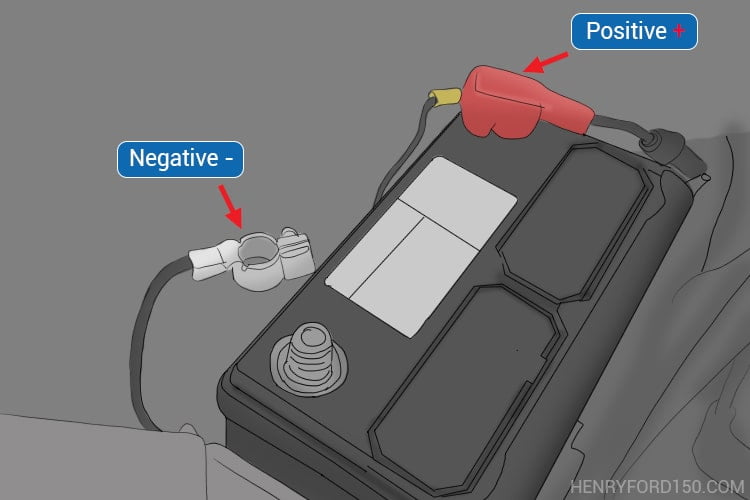
Step 3: Look for the PCM.
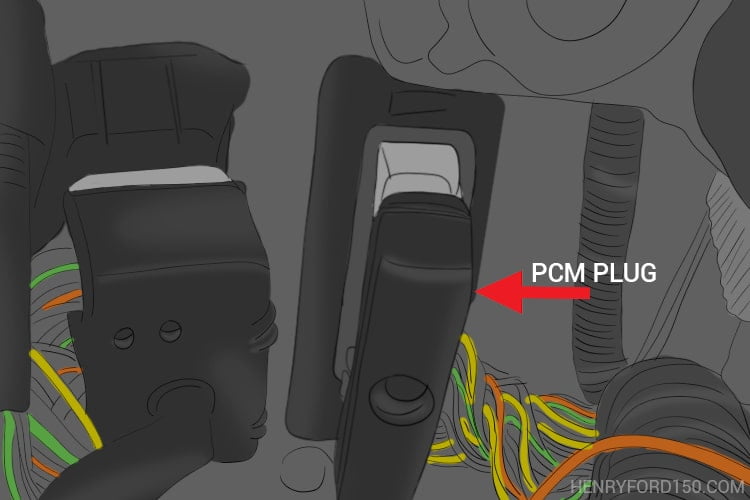
Step 4: Take note of the numbers printed on the module.

Step 5: Look up the PCM number based on the vehicle model, vehicle year, and drive train parts. You can get the right PCM type for your vehicle thanks to the number. Ensure that the mounting locations, connectors, and barcodes match.
Step 6: Buy the new unit.
Step 7: Unplug the old module carefully.
Step 8: Carry out any necessary flash updates before plugging the replacement unit.
Step 9: Make the installation.
Step 10: Reconnect the truck’s battery in the reverse order you disconnected it.
Step 12: Start the vehicle to test the new unit.
Note: Keep in mind that most stores won’t let you return the product once it has been connected.
PCM Replacement & Reprogramming Cost
The total cost of replacing a Ford F150’s powertrain control module is between $700 and $1,500. This depends on the vehicle model and labor charges. Some PCMs are more complex than others, and luxury F150 trucks would be more expensive than regular ones. A seasoned expert would charge higher than a professional with lesser experience.
Most of your budget would go to getting a replacement unit. The cost of obtaining one could be between $500 and $1000. Labor charges range from $90 to $120 per hour. Save on that by performing the replacement yourself if you have the needed DIY know-how. Depending on the location, reprogramming costs are usually between $75 and $150.
It may take about 30 minutes for the auto electrician to reprogram the module. However, keep in mind that they charge hourly rates. Choose a technician that has the necessary experience in PCM programming. Another option is to patronize a trustworthy dealership. Dealership repairs are usually more expensive than those of independent auto electricians.
Aftermarket PCMs are typically cheaper than OEM PCMs, but the former may not work after the replacement. It is hard to make a copy of the exact software needed, so only the manufacturer may be able to provide it.
Some vehicle manufacturers execute strategies to discourage the aftermarket replacement of PCMs. One of them is the creation of special manufacturer codes to resolve selected issues. An aftermarket replacement may void the manufacturer’s powertrain warranty of a newer F150 model. The best option is the use of an OEM module for the swap.
You can get a used PCM to replace your old faulty one from an online store. It could cost just a few hundred dollars. Used PCMs can also be sourced at junkyards.
Ford F150 PCM Failure Symptoms – Frequently Asked Questions
Q1: What does the PCM stand for on a Ford F150?
Answer:
PCM is the acronym for Powertrain Control Module, the computerized brain of a modern automobile. Your Ford truck can’t work well without it, just as how the human body can’t function properly when the brain has a defect. Furthermore, the PCM controls the two major parts of a powertrain, the engine and transmission, and several other vehicle parts.
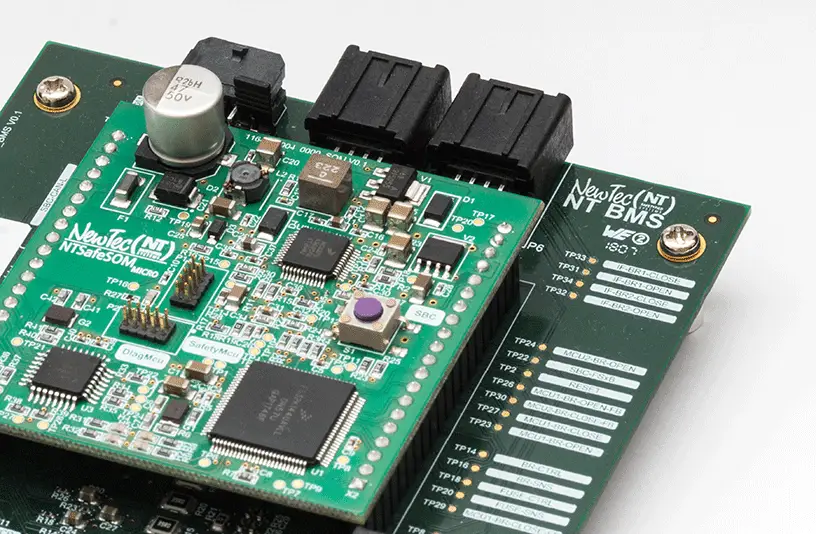
Q2: Where is the PCM located in Ford F 150?
Answer:
Most recent F150s have the PCM positioned at the back of the driver’s kick panel with the connector projecting through the firewall.
The PCM’s shape is like a box and is made of metals. It is connected to other vehicle sensors with the aid of wires.
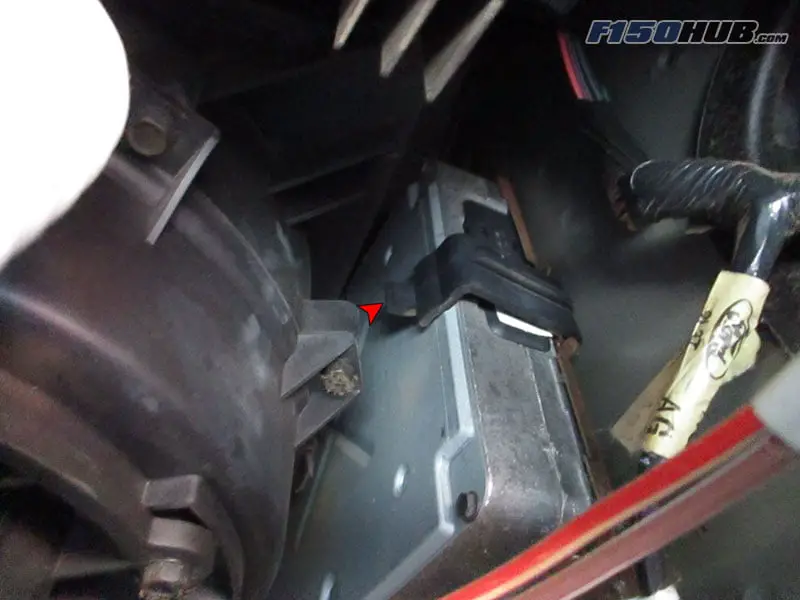
Q3: How Does the Ford F150 PCM Work?
Answer:
A powertrain control module works according to the information it gets from the other sensors linked to it. Examples are fuel pressure sensors, airflow sensors, throttle position sensors, etc. The sensors help the PCM monitor the computer systems. This makes it easy for the unit to manage almost every truck system, apart from processing power. It can handle more than a hundred roles at a time. See examples of its duties below.
- Determining the right timing for firing the spark plugs.
- Calculating the appropriate moment for an automatic transmission to shift to various gears for optimal performance.
- Deciding the amount of fuel that each cylinder gets.
- Alerting the driver about an issue by triggering the check engine light to come on and flashing error codes.
Good engine performance, fuel efficiency, gear shift, and so on are ensured when the module is in great condition. Your vehicle will work efficiently and smoothly when there is a good communication flow between the PCM, the sensors, and other computers. A possible way to know that something is wrong with the module is when the check engine light comes on.
Q4: PCM vs. ECM: What are the differences?
Answer:
The main difference between PCM (Powertrain Control Module) and ECM (Engine Control Module) is that: While ECM controls specific parts of the engine, regulating and sending commands, PCM handles almost all engine functions in newer models.
However, the two terms can sometimes be used interchangeably as a control unit for the engine/transmission system.
Final Thoughts
I hope you found the answers to many of your bugging questions about Ford F150 PCM failure symptoms. Now you know what to do when you notice any of the top 9 most common PCM problems mentioned. You have also realized just how important the powertrain control module is. Remember to deal with PCM (in Ford F150) issues as soon as possible to avoid incurring higher costs from complications.